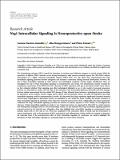Por favor, use este identificador para citar o enlazar a este item:
http://hdl.handle.net/10261/215100COMPARTIR / EXPORTAR:
 SHARE SHARE
 CORE
BASE CORE
BASE
|
|
| Visualizar otros formatos: MARC | Dublin Core | RDF | ORE | MODS | METS | DIDL | DATACITE | |

| Campo DC | Valor | Lengua/Idioma |
|---|---|---|
| dc.contributor.author | Navarro-González, Carmen | - |
| dc.contributor.author | Huerga-Gómez, Alba | - |
| dc.contributor.author | Fazzari, Pietro | - |
| dc.date.accessioned | 2020-06-24T09:50:09Z | - |
| dc.date.available | 2020-06-24T09:50:09Z | - |
| dc.date.issued | 2019-09-08 | - |
| dc.identifier | doi: 10.1155/2019/3930186 | - |
| dc.identifier | issn: 1942-0994 | - |
| dc.identifier.citation | Oxidative Medicine and Cellular Longevity 2019 (2019) | - |
| dc.identifier.uri | http://hdl.handle.net/10261/215100 | - |
| dc.description.abstract | The schizophrenia risk gene NRG1 controls the formation of excitatory and inhibitory synapses in cortical circuits. While the expression of different NRG1 isoforms occurs during development, adult neurons primarily express the CRD-NRG1 isoform characterized by a highly conserved intracellular domain (NRG1-ICD). We and others have demonstrated that Nrg1 intracellular signaling promotes dendrite elongation and excitatory connections during neuronal development. However, the role of Nrg1 intracellular signaling in adult neurons and pathological conditions remains largely unaddressed. Here, we investigated the role of Nrg1 intracellular signaling in neuroprotection and stroke. Our bioinformatic analysis revealed the evolutionary conservation of the NRG1-ICD and a decrease in NRG1 expression with age in the human frontal cortex. Hence, we first evaluated whether Nrg1 signaling may affect pathological hallmarks in an in vitro model of neuronal senescence; however, our data failed to reveal a role for Nrg1 in the activation of the stress-related pathway p38 MAPK and DNA damage. Previous studies demonstrated that the soluble EGF domain of Nrg1 alleviated brain ischemia, a pathological process involving the generation of free radicals, reactive oxygen species (ROS), and excitotoxicity. Hence, we tested the hypothesis that Nrg1 intracellular signaling could be neuroprotective in stroke. We discovered that Nrg1 expression significantly increased neuronal survival upon oxygen-glucose deprivation (OGD), an established in vitro model for stroke. Notably, the specific activation of Nrg1 intracellular signaling by expression of the Nrg1-ICD protected neurons from OGD. Additionally, time-lapse experiments confirmed that Nrg1 intracellular signaling increased the survival of neurons exposed to OGD. Finally, we investigated the relevance of Nrg1 intracellular signaling in stroke in vivo. Using viral vectors, we expressed the Nrg1-ICD in cortical neurons and subsequently challenged them by a focal hemorrhagic stroke; our data indicated that Nrg1 intracellular signaling improved neuronal survival in the infarcted area. Altogether, these data highlight Nrg1 intracellular signaling as neuroprotective upon ischemic lesion both in vitro and in vivo. Given the complexity of the neurotoxic effects of stroke and the involvement of various mechanisms, such as the generation of ROS, excitotoxicity, and inflammation, further studies are required to determine the molecular bases of the neuroprotective effect of Nrg1 intracellular signaling. In conclusion, our research highlights the stimulation of Nrg1 intracellular signaling as a promising target for cortical stroke treatment. | - |
| dc.description.sponsorship | Ministry of Economy and Competitiveness, grants RYC2014-16410 and SAF2017-89020-R. We also thank the support of the Conselleria de Sanitat of the Generalitat Valenciana which is funding the salary of CN via the Centro de Investigación Príncipe Felipe | - |
| dc.language | eng | - |
| dc.relation.isversionof | Publisher's version | - |
| dc.rights | openAccess | - |
| dc.title | Nrg1 Intracellular Signaling Is Neuroprotective upon Stroke | - |
| dc.type | artículo | - |
| dc.identifier.doi | 10.1155/2019/3930186 | - |
| dc.relation.publisherversion | http://dx.doi.org/10.1155/2019/3930186 | - |
| dc.date.updated | 2020-06-24T09:50:09Z | - |
| dc.rights.license | https://creativecommons.org/licenses/by-nc-nd/4.0/ | - |
| dc.contributor.funder | Ministerio de Economía y Competitividad (España) | - |
| dc.contributor.funder | Generalitat Valenciana | - |
| dc.contributor.funder | Centro de Investigación Príncipe Felipe (España) | - |
| dc.relation.csic | Sí | - |
| dc.identifier.funder | http://dx.doi.org/10.13039/501100003329 | es_ES |
| dc.identifier.funder | http://dx.doi.org/10.13039/501100003359 | es_ES |
| dc.identifier.pmid | 31583038 | - |
| dc.type.coar | http://purl.org/coar/resource_type/c_6501 | es_ES |
| item.cerifentitytype | Publications | - |
| item.openairecristype | http://purl.org/coar/resource_type/c_18cf | - |
| item.grantfulltext | open | - |
| item.openairetype | artículo | - |
| item.fulltext | With Fulltext | - |
| Aparece en las colecciones: | (CBM) Artículos | |
Ficheros en este ítem:
| Fichero | Descripción | Tamaño | Formato | |
|---|---|---|---|---|
| FazzariP_Nrg1Intracellular.pdf | 10,21 MB | Adobe PDF |  Visualizar/Abrir |
CORE Recommender
PubMed Central
Citations
10
checked on 25-abr-2024
SCOPUSTM
Citations
15
checked on 01-may-2024
WEB OF SCIENCETM
Citations
14
checked on 26-feb-2024
Page view(s)
94
checked on 05-may-2024
Download(s)
135
checked on 05-may-2024

